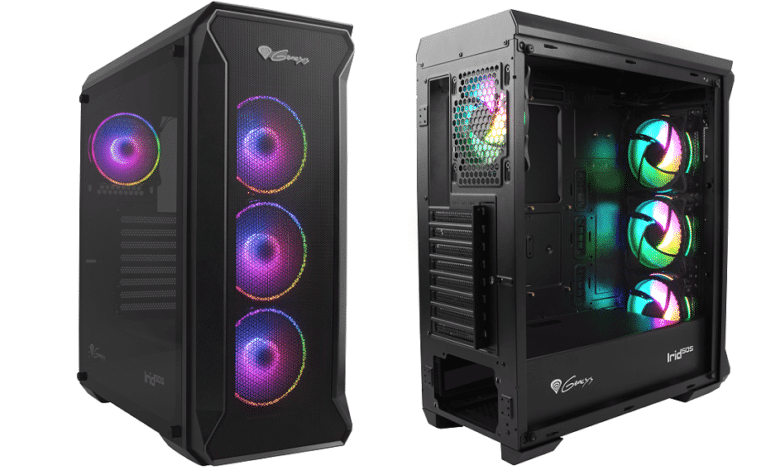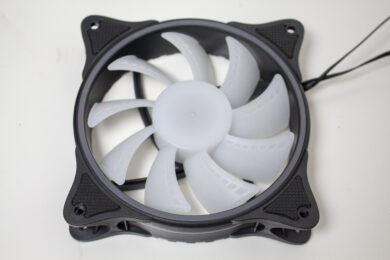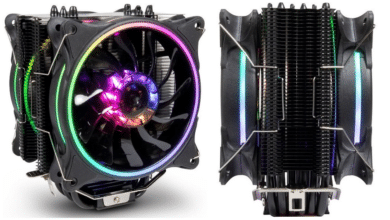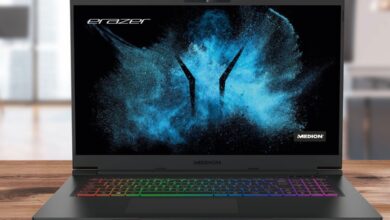
Behind the name Genesis is a Polish manufacturer of PC components. After its foundation in 2011, the manufacturer’s main focus was initially on gaming components such as input devices, PC accessories and audio devices. In the meantime, however, more and more divisions have been added. These now also include PC cases.
We’ll take a closer look at one of these numerous cases today. The cases of the Irid series are supposed to combine high functionality with an extraordinary look. This is no different with the Genesis Irid 505. Behind this name is a large midi tower with a mesh front and plenty of space inside. Thanks to the four pre-installed RGB fans and the Tempered Glass side panel, this midi tower should not only be able to cool the hardware well, but also put it in a particularly good light. With a price of about 75 Euros, the Genesis Irid 505 is not that far away from the competition. Whether this midi tower can convince us, you can find out in this review.
Technical details
| Model: | Genesis Irid 505 ARGB |
| Case type: | ATX |
| Dimensions: | 220 mm (W) x 510 mm (H) x 447 mm (D) |
| Weight: | 6.95 kg |
| Material: | Steel, plastic, tempered glass |
| Color: | Black |
| Front connectors | 2x USB 3.0 Type-A, 2x USB 2.0 Type-A, 1x headphone, 1x microphone |
| Drive bays: | 2x 3.5″/ 2.5″ (internal) 2x 2.5″ (internal) |
| Expansion slots: | 8x horizontal |
| Shape factors: | ATX, mATX, ITX |
| Ventilation: | Front: 3x 120 mm or 2x 140 mm. Rear: 1x 120 mm Lid: 2x 120 mm or 2x 140 mm |
| Radiators: | Front: 1x 280 mm or 1x 240 mm. Rear: 1x 120 mm Lid: 1x 280 mm or 1x 240 mm |
| Max. CPU cooler height: | 165 mm |
| Max. Graphics card length: | 380 mm |
| Max. Net part length: | 170 mm (with HDD cage), unlimited (without HDD cage) |
| Cable management space: | 29 mm |
| Price: | € 76.99 * |
| Features: | Dust filter, Cable management, Tempered Glass, PWM ARGB controller |
Scope of delivery
Genesis packages the Irid 505 RGB in a mostly brown cardboard box, but with some red accents. Printed on the box are a picture of the midi tower, technical specs, and key features. Inside, the case is encased in two regular styrofoam blocks and a plastic film. As an additional protection for the side window, the manufacturer has placed a one centimeter thick foam mat in front of the glass and covered it with a protective film on both sides. The accessories are located inside in a bag. This contains all important screws, five black cable ties, an MB speaker, installation instructions and a nut for screwing in spacers. Also included are the four pre-installed case fans with RGB lighting (120cmm), the RGB control board and three pre-installed dust filter mats.
Exterior impression
Where in recent years the closed fronts made of tempered glass were on the rise, many manufacturers are increasingly rowing back and, in favor of a much better airflow, rely on a front panel made of classic mesh. This is also what the manufacturer did with the Irid 505. The front panel is mostly made of mesh, which is surrounded by a plastic frame. This frame is a bit wider at the top and bottom than in the middle and has the manufacturer’s logo on the top. With a strong tug, the front panel can be removed to reveal the three pre-installed ARGB fans and a magnetic dust filter behind it.
The lid is completely made of steel and follows the front panel in design and function. Thus, it offers mounting points for installing two 120- or 140-millimeter fans through a large opening. A magnetic dust filter mat also enhances the appearance and protects the interior from dust. The I/O panel is also found in the lid. There are a total of three buttons (power, reset, LED), four USB ports (2x USB 3.0, 2x USB 2.0) and one jack each for headphones and a microphone.
Since the Irid 505 has RGB effects, a Tempered Glass side panel is of course a must. This is, as usual, on the left side and is connected to the body with four flat metal thumbscrews. The glass is slightly darkened, but still allows a good view of the components. The right side panel is made of steel and is connected to the rest of the tower with two normal thumbscrews. In addition, a small recessed grip at the rear end of the panel should make disassembly easier. The steel has a thickness of 0.65 and the glass of 4 millimeters.
The rear panel corresponds to the current standard for midi-tower. The PSU is mounted at the bottom, resting on two thin strips of foam rubber. Above the PSU are eight reusable PCI slot bezels, which are also perforated. The fourth pre-installed ARGB fan can be found at the very top. Another striking thing about the rear is that there is a relatively large amount of space between the fan and the lid.
The Genesis Irid 505 stands on four plastic feet, each of which is covered with a rubber strip to minimize vibrations and protect the surfaces. Otherwise, the simple dust filter for the power supply and four screws can be seen on the underside. The latter could be used to remove the HDD cage.
The outer impression leaves us with mixed feelings. The appearance is basically chic, but of course always a matter of taste. What bothers us, on the other hand, is partly the material quality. The steel of the side panel is relatively thin for a case in this price range and the feet also leave a rather cheap impression. Furthermore, our sample had a small but visible scratch on the lid, which should have been noticed in the quality control.
Interior impression
In the interior, Genesis does not dare to experiment and relies on the proven division into two chambers. The large chamber in the upper area offers space for ATX mainboards and, due to the eight PCI slots, theoretically also room for up to four dual-slot graphics cards. The 0.6 millimeter thick mainboard tray has five large openings for routing cables and a cutout for retrofitting CPU coolers with backplates. To further improve the appearance, the three openings on the right side have also been fitted with rubber sleeves. Since there are no hard drive cages in the right area of the interior, the three front fans can transport cool air into the interior unhindered.
In the lower area of the interior, the almost completely closed power supply cover can be seen. Only two, also rubberized, cable management openings and a cutout in the front area are present. The latter is supposed to allow the installation of a radiator. Furthermore, the manufacturer’s logo and the case’s name have been printed on the side.
Under the cover, as usual, the PSU finds its place and rests on two thin rubber strips for noise reduction. In front of the PSU is the removable or relocatable HDD cage. But more about that in a moment. Just like on the front, the rear is also quite spacious. With almost 30 millimeters of space for cables, even the laziest of users should be able to route the cables so that the side panel can be closed. The space is supplemented by sensibly placed tabs for cable ties. The upper left area houses the RGB and PWM control board for the pre-installed fans.
Lastly, let’s move on to the storage options for data media in the Genesis Irid 505 ARGB. The cage under the cover is used to accommodate two 3.5″ or two 2.5″ HDDs. Simple plastic frames are used for this. There is no decoupling here. The cage can be moved or completely removed by removing five screws. On the other hand, two additional 2.5″ data carriers can be stowed directly behind the motherboard. They are attached via normal screws to a steel frame, which in turn is screwed to the motherboard tray. There is no decoupling here either.
The interior layout is purposeful, offering plenty of space for components and generally good features. However, in one or two places you notice that the manufacturer has had to save money or has invested in other features. For example, the motherboard tray is made of quite thin steel and can easily be moved with a finger. However, we couldn’t cause any permanent deformations.
System build in the Genesis Irid 505 ARGB
Now we come to the installation of the system. For hardware, we’re using a AMD Ryzen 5 1400 on a MSI B350 PC Mate with 16GB Crucial Ballistix Sport LT gray DDR4-2666. The Ryzen is cooled by an Enermax ETS-F40 Silent Edition* and is overclocked to 3.8GHz (1.25V). A GTX 1060 6GB from Gigabyte AORUS is responsible for the image output. The power supply is handled by the fully modular LC-Power LC550 V2.31 Platinum with an efficiency rating of 80 Plus Platinum.
The installation of the test system turned out to be very easy and was completed quickly. The reason for this is the good amount of space and the well thought-out layout. There is enough space above and beside the motherboard to work with larger hands. The pre-installed spacers also save more time during assembly. Also, the space for routing cables behind the motherboard tray and the sensibly placed cable management openings made installation immensely easier and allowed for neat cabling of components. The overall result looks neat and tidy.
The Irid 505 can also convince with its hardware compatibility. It offers space for 165 millimeter high CPU coolers and 380 millimeter long graphics cards. According to the manufacturer, two 280-millimeter radiators can also be installed. At least 170 millimeters are available for power supplies when the HDD cage remains installed.
As already mentioned, the Irid 505 ARB comes with four pre-installed fans ex-factory. These consist of a black frame and milky rotors with 9 fan blades each. The LEDs have been placed in the fan hub and shine outwards. The fans are connected via a 3-pin cable for power and a 3-pin header to control the LEDS. The speed range is between 500 and 1500 rpm.
Lastly, we come to the temperatures that were reached in the Genesis Irid 505 ARGB. During the stress test, Prime95 and FurMark were run for 15 minutes at a room temperature of about 18 °C. Furthermore, the test was performed with two different fan speeds.
Scenario |
Temperature |
| CPU: 50% PWM (1050 rpm) GPU: 50% PWM (1650 rpm) 4x 120 mm on 100% PWM (1500 rpm) |
CPU: 65 °C GPU: 62 °C |
| CPU: 50% (1050 rpm) GPU: 50% PWM (1650 rpm) 4x 120 mm on 50% PWM (1000rpm) |
CPU: 68 °C GPU: 65 °C |
With four fans pre-installed, the Genesis Irid 505 ARG doesn’t have to hide when it comes to cooling performance. Even with reduced fan speeds, none of the components reach a critical temperature range. However, the fans are clearly audible at full speed and a slight noise is still perceptible at 1000 rpm. However, since the fans can be easily controlled via the PCB, it is very easy to find a good middle ground between temperature and volume.
Lighting Options in the Genesis Irid 505 ARGB
As the name of the midi tower suggests, the pre-installed and digitally addressable lighting in the Irid 505 is one of the main features. This is achieved by the four pre-installed RGB fans. The LEDs are controlled digitally via the control board on the back. This offers a total of six 3-pin 5V RGB connectors for the LEDs and six conventional 3-pin ports for powering the fans. Speed is then monitored via a single 4-pin PWM connector that plugs into the motherboard. Power for the entire board is provided by a SATA power connector. Changing modes is done either directly via the mainboard or, if it doesn’t have a 3-pin 5V ARGB header, via the button in the I/O panel. Without the mainboard, the control board has a total of 64 different modes or color combinations.
We can only praise the use of a system with standard connectors at this point. Thus, if necessary, more fans can be added or the old ones can be replaced without having to change the board. Finally, a few impressions of the activated lighting.
Conclusion on the Genesis Irid 505 ARGB
Now let’s get to the final conclusion of this review. The Genesis Irid 505 ARGB leaves us with a mixed impression. We liked the spacious build and the solid features. This includes a glass side window, three dust filters and four pre-installed ARGB case fans including a control board with standard connectors. Only for the fans you can put 50€ to 60€ on the table at other manufacturers. Due to the number of fans and the mesh front panel, even high-end systems should cool well in the Irid 505.
However, the manufacturer had to make concessions in other areas for a price of 75 €. The material thickness is borderline thin in places and the feet also look rather cheap. In addition, there are very simple dust filters for the power supply and of course the conspicuous scratch of our test sample, which was apparently not noticed in the quality control.
If you want to buy a spacious midi tower for as little money as possible, which is already suitable for presenting your hardware well ex works, then the Genesis Irid 505 ARGB could be a possible candidate. In this case, however, you have to put up with one or two flaws.
Genesis Irid 505 ARGB
Workmanship
Structure
Features
Cooling
Value for money
85/100
The Genesis Irid 505 ARGB is a well-equipped and spacious midi tower with four pre-installed ARGB fans that provide good airflow. However, the material quality has been cut back in one or two places.




















































